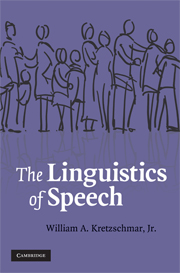Book contents
- Frontmatter
- Contents
- List of figures
- List of tables
- Acknowledgments
- The road not taken
- Introduction
- 1 The contemporary marketplace of ideas about language
- 2 Saussure
- 3 Evidence from linguistic survey research: basic description
- 4 Statistical evidence from linguistic survey research
- 5 Evidence from corpus linguistics
- 6 Speech as a complex system
- 7 Speech perception
- 8 Speech models and applications
- References
- Index
4 - Statistical evidence from linguistic survey research
Published online by Cambridge University Press: 03 July 2009
- Frontmatter
- Contents
- List of figures
- List of tables
- Acknowledgments
- The road not taken
- Introduction
- 1 The contemporary marketplace of ideas about language
- 2 Saussure
- 3 Evidence from linguistic survey research: basic description
- 4 Statistical evidence from linguistic survey research
- 5 Evidence from corpus linguistics
- 6 Speech as a complex system
- 7 Speech perception
- 8 Speech models and applications
- References
- Index
Summary
Yet another modern development also addresses, though in a different way, Saussure's complaint that “language in its totality is unknowable” – modern methods of sampling and inferential statistics. Probability theory in mathematics, as it is used in inferential statistics, was certainly available to Saussure, but modern applications of the mathematical principles of probability to inferential statistics mostly occurred after his time. Thomas Bayes, for instance, after whom “Bayesian statistics” and “Bayesian probability” and “Bayesian inference” are named (these notions reflect input probabilities, or perceived probabilities, in the drawing of statistical inferences), lived in the eighteenth century, which is also the time that the notion “statistics” originated in connection with census data. Yet it is unlikely that Bayes himself would recognize the concepts to which his name has been attached, which are currently important in domains such as search engine performance and email spam control. Applications of statistics in manufacturing and science, and the great refinement of its potential, only occurred during the twentieth century. William Sealy Gosset, who used the pseudonym “Student” and originated the “Student's t-test,” worked for the Guinness brewery at just about the time that Saussure was teaching the Course. Gosset developed his small-sample test as an industrial tool, for use in quality control in the brewery and to maximize barley yields on its associated farms.
- Type
- Chapter
- Information
- The Linguistics of Speech , pp. 104 - 145Publisher: Cambridge University PressPrint publication year: 2009

